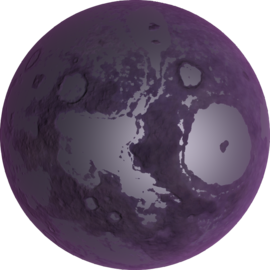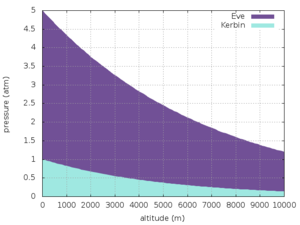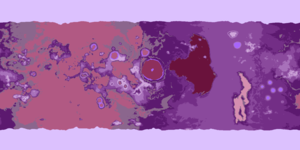Eve
| Eve | ||
| Eve as seen from orbit. | ||
| Planet of Kerbol | ||
| Orbital Characteristics | ||
| Semi-major axis | 9 832 684 544 m [Note 1] | |
| Apoapsis | 9 931 011 387 m [Note 1] | |
| Periapsis | 9 734 357 701 m [Note 1] | |
| Orbital eccentricity | 0.01 | |
| Orbital inclination | 2.1 ° | |
| Argument of periapsis | 0 ° | |
| Longitude of the ascending node | 15 ° | |
| Mean anomaly | 3.14 rad (at 0s UT) | |
| Sidereal orbital period | 5 657 995 s | |
| 261 d 5 h 39 m 55.1 s | ||
| Synodic orbital period | 14 687 035.5 s | |
| Orbital velocity | 10 811 - 11 029 m/s | |
| Physical Characteristics | ||
| Equatorial radius | 700 000 m | |
| Equatorial circumference | 4 398 230 m | |
| Surface area | 6.1575216×1012 m2 | |
| Mass | 1.2243980×1023 kg | |
| Standard gravitational parameter | 8.1717302×1012 m3/s2 | |
| Density | 85 219.677 kg/m3 | |
| Surface gravity | 16.7 m/s2 (1.701 g) | |
| Escape velocity | 4 831.96 m/s | |
| Sidereal rotation period | 80 500.000 s | |
| 3 d 4 h 21 m 40 s | ||
| Solar day | 81 661.857 s | |
| 3 d 4 h 41 m 1.9 s | ||
| Sidereal rotational velocity | 54.636 m/s | |
| Synchronous orbit | 10 328.47 km | |
| Sphere of influence | 85 109 365 m [Note 1] | |
| Atmospheric Characteristics | ||
| Atmosphere present | Yes | |
| Atmospheric pressure | 506.625 kPa | |
| 5 atm | ||
| Atmospheric height | 90 000 m | |
| 5.0×10-6 atm | ||
| Temperaturemin | -113.13 °C 160.02 K | |
| Temperaturemax | 146.85 °C 420 K | |
| Oxygen present | No | |
| Scientific multiplier | ||
| Surface | 8 | |
| Splashed | 8 | |
| Lower atmosphere | 6 | |
| Upper atmosphere | 6 | |
| Near space | 7 | |
| Outer space | 5 | |
| Recovery | 5 | |
|
| ||
Eve is the second planet from Kerbol, the closest planet to Kerbin, and KSP's analogue for the planet Venus. It has one small moon: a captured asteroid called Gilly. Because of the atmosphere it's the hardest planet to return from after landing. There is a tutorial about getting to Eve.
Contents
In-game Description
| “ | Eve is certainly the purplest object in the solar system. Its one of the larger, most visible objects, mainly because of its very, very purple tint. It is considered by some to be an almost sister planet to Kerbin. Well, despite the purple, and the toxic atmosphere, and the extreme pressures and temperatures… Actually, it’s not very similar at all is it? Who are these people? — Kerbal Astronomical Society |
” |
Topography
The surface of Eve looks not unlike that of Saturn's largest moon, Titan. It has several oceans, among which lie large, flat continents. The terrain has a few mountain peaks, but mostly consists of rolling hills that resemble purple sand dunes. These are speckled with small boulders, no doubt worn down by Eve's pressure, temperature, and wind. Eve's surface is covered with craters. The composition of the violet liquid which fills the oceans and lakes is unknown, although water remains a possibility: the boiling point of water is slightly higher than the surface temperature when taking the high atmospheric pressure into account.[1] According to the devs during a livestream, it was joked that the lakes were made of rocket fuel[citation needed]. Eve's highest mountain range has a peak of 7526 m.
Atmosphere
Eve's atmosphere begins at 96,708.6 m and is extremely dense: at 11,250 m, it's as thick as Kerbin's atmosphere at sea level (1 atm), and at Eve sea level the atmospheric pressure is 5 atm. Its atmospheric pressure fades exponentially, with a scale height of 7000 m. The atmosphere should be superheated due to the thick atmosphere trapping in heat, much like Venus, but this is not currently implemented.
In general, the atmospheric pressure on Eve at an altitude expressed in meters is:[2]
From within Eve's atmosphere, the sky appears indigo during nighttime and a violet-purple color during daytime. During dawn and dusk, the sky is green.
Jet engines do not function in Eve's atmosphere, since it contains no oxygen — they make noise and consume fuel, but they produce no thrust. Planes with other propulsion methods do, however, work very well, and are a great way to explore the planet. They work best between 35 km and 25 km where the atmosphere generates enough lift to glide and steer, but not enough drag to slow the aircraft excessively.
Landing legs on Eve can easily break because of Eve's high gravity and, surprisingly enough, atmospheric pressure.
As of version 0.90[outdated], an aerobraking maneuver arriving from Kerbin and resulting in orbit around Eve — without using fuel for braking — can be done aiming for a periapsis between 70 km (for low-energy transfer) and 55 km (for high-energy transfers).
The following table gives terminal velocities at different Eve altitudes. These are also the velocities at which a ship should travel for a fuel-optimal ascent from Eve, given the game's model of atmospheric drag.[3]
| Altitude (m) | Velocity (m/s) |
|---|---|
| 0 | 58.4 |
| 1000 | 62.5 |
| 5000 | 82.0 |
| 10000 | 115 |
| 15000 | 162 |
| 20000 | 228 |
| 30000 | 450 |
| 40000 | 888 |
| 50000 | 1.76×103 |
| 60000 | 3.47×103 |
Science
Eve's orbit and atmosphere have a science multiplier of 7, which is rather average. But the surface has a multiplier of 12, which is the third highest science multiplier in the whole star system. Eve has 7 biomes with their own science to be collected. It has several Explodium Seas, among which lie large continents.
Biome list
|
Natural satellites
Eve's only natural satellite is the tiny captured asteroid Gilly in a highly eccentric and inclined orbit. Gilly is the smallest celestial body in the Kerbol system.
Orbital statistics
Visiting Eve potentially requires the least delta-v of any planet because its huge gravity well and dense atmosphere mitigate the difficulties that its slight relative inclination poses and greatly ease aero-captures, transfers, and landings; unfortunately, takeoff and escape therefore require the most delta-v of any celestial body with a solid surface.
The combination of high gravity and thick atmosphere makes return missions from the sea level of Eve very difficult. It requires about 11,500 m/s of delta-v to get into orbit from sea level. Driving to and launching from the peak of one of Eve's mountains can drastically reduce the amount of delta-V required (thus allowing successful launches with significantly lighter rockets). The highest peak on Eve since version 0.21.1 is 7540 m high, found near (25° S, 158.5° W)
| Altitude (m) | Delta-V Required (m/s) |
|---|---|
| 0 | 11,282 |
| 1000 | 10,731 |
| 2000 | 10,219 |
| 3000 | 9,743 |
| 4000 | 9,300 |
| 5000 | 8,888 |
| 6000 | 8,507 |
| 7000 | 8,150 |
| 7540 | 7,968 |
A synchronous orbit of Eve requires an altitude of 10373.195 km and a velocity of 858.95 m/s. For a semisynchronous orbit of ½ Eve day (11.25 hours or 40500 seconds) an orbit of 6275.676 km above Eve is needed with a velocity of 1082.2 m/s.
Reference Frames
| Time warp | Minimum Altitude |
|---|---|
| 1× | Any |
| 5× | 90 000 m (above the atmosphere) |
| 10× | 90 000 m (above the atmosphere) |
| 50× | 90 000 m (above the atmosphere) |
| 100× | 120 000 m |
| 1 000× | 240 000 m |
| 10 000× | 480 000 m |
| 100 000× | 600 000 m |
Gallery
Bugs
- Eve has higher gravity than Kerbin, restricting a Kerbal's jump to only half a meter and making EVA jets useless. This being said, if a Kerbal falls from more than 4 m, they will hit the ground much harder than on Kerbin, which may cause a glitch to happen in which they will clip into the terrain and accelerate away from Eve at phenomenal speed, sometimes faster than the speed of light itself, usually sending the unlucky Kerbal on an escape trajectory from Kerbol if they are not killed by the fall. They may bring something into interstellar space with them if they hit an object instead of the ground.
- Solar panels will probably break off in flight, even with very low velocity. It's best to wait to extend them till stable on the surface, however they can break on the surface of Eve even when retracted. This may be due to Eve's high gravity.
- Rovers can be challenging to drive on Eve due to its gravity. The rover's wheels will easily break, but on the upside, since the gravity pulls them lower on their shocks and thus lowers the centre of mass, they will be harder to flip over. Although not a glitch, it could cause clipping issues with a kerbals sitting in EAS-1 External Command Seats
- When landing fast, craft will sometimes sink into the surface of Eve. This can be fixed by using landing legs to lift the ship up.
Changes
- Added biomes
- Terrain Tweaks — more land mass to the surface
- Art pass.
- Terrain tweaks — the tallest points are now about 6 km in altitude, compared to 11 km before.
- Initial Release
Notes
- ↑ According to WolframAlpha the boiling temperature is about 2.5 K higher than the highest temperature measured.
- ↑ A LV-N Atomic Rocket Motor has a specific impulse of 220 in 1 atm or higher, 800 in vacuum, and the following at various Eve altitudes:
altitude (m) 11263 11268 11322 11598 11896 12200 12799 13868 14586 15292 16725 18711 22800 23556 32000 38000 43000 51963 specific impulse 220 220.2 224.6 246.9 269.9 292.4 334.0 400.0 438.8 473.4 533.7 600.2 688.2 699.8 769.8 787.3 793.8 798.3 - ↑ http://forum.kerbalspaceprogram.com/showthread.php/6664-Mini-challenge-max-altitude-with-this-supplied-spacecraft?p=100912&viewfull=1#post100912













